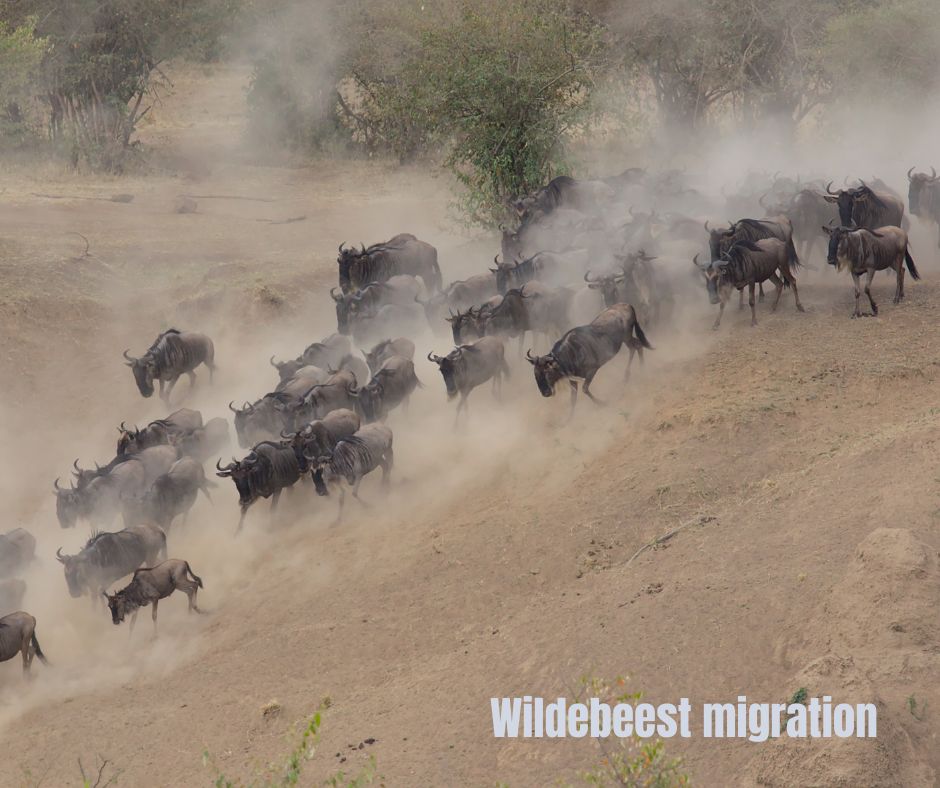The wildebeest migration season is one of the most awe-inspiring natural events on the planet. Every year, over 1.5 million wildebeest, along with hundreds of thousands of zebras and gazelles, embark on a perilous journey across the plains of East Africa. This epic migration, often referred to as the “Great Migration,” is a thrilling spectacle that draws travelers and wildlife enthusiasts from around the world. With Royal Star Expeditions, you can witness this incredible event up close and personal.
1. Understanding the Wildebeest Migration Season
The wildebeest migration season is a year-long cycle that takes place between Tanzania’s Serengeti National Park and Kenya’s Maasai Mara National Reserve. The migration is driven by the search for fresh grazing and water, as the herds follow the rains in a clockwise pattern across the plains.
The Migration Route
The migration begins in the southern Serengeti, where the wildebeest calve in the months of January and February. This is a time of plenty, with lush grasses providing nourishment for the new calves. As the dry season approaches, the herds begin their journey northward. By June, they reach the western corridor of the Serengeti, where they must cross the Grumeti River—a dangerous obstacle filled with crocodiles waiting for their next meal.
The migration then continues towards the Mara River, another perilous crossing where the risk of drowning and predators like lions and crocodiles is high. By July or August, the herds reach the Maasai Mara, where they spend several months feeding on the lush grasses before beginning their journey back to the Serengeti in October.
2. Best Time to Experience the Wildebeest Migration Season
Timing is everything when it comes to witnessing the wildebeest migration season. The migration is a continuous cycle, but certain periods offer the best opportunities to see specific events.
Calving Season (January – February)
The calving season in the southern Serengeti is an excellent time to visit if you want to witness the birth of thousands of wildebeest calves. This period also attracts numerous predators, making for thrilling game drives.
River Crossings (July – August)
The river crossings are perhaps the most dramatic and sought-after events of the wildebeest migration season. The crossings at the Grumeti and Mara rivers are filled with tension as the wildebeest face the dangers of the water and the predators that lie in wait. July and August are the peak months for river crossings in the Maasai Mara.
Return to Serengeti (October – November)
As the wildebeest make their way back to the Serengeti, this period offers a quieter, yet equally captivating experience. The herds move southward, and the landscape begins to green once more with the onset of the short rains.
3. Planning Your Safari with Royal Star Expeditions
Royal Star Expeditions offers expertly guided safaris that ensure you’re in the right place at the right time to witness the highlights of the wildebeest migration season. Here’s what you can expect when planning your trip:
Tailored Itineraries
Royal Star Expeditions understands that each traveler is unique, and they offer tailored itineraries to suit your preferences. Whether you’re interested in the calving season, river crossings, or the return journey, their experienced guides will ensure you have the best vantage points to witness the action.
Accommodation Options
From luxurious lodges to mobile camps that move with the migration, Royal Star Expeditions offers a range of accommodation options. Staying in a mobile camp allows you to be close to the action, maximizing your chances of witnessing key moments of the wildebeest migration season.
Expert Guides
The guides at Royal Star Expeditions are seasoned professionals with in-depth knowledge of the migration patterns and wildlife behavior. Their expertise ensures that you not only see the migration but also gain a deeper understanding of the ecosystem and the challenges the animals face.
4. Why the Wildebeest Migration Season is a Must-See
The wildebeest migration season is more than just a wildlife event; it’s a natural phenomenon that symbolizes the resilience and survival instincts of the animal kingdom. Watching thousands of wildebeest and other herbivores navigate the treacherous landscape, facing predators and natural obstacles, is both humbling and exhilarating.
A Unique Photography Opportunity
For photographers, the wildebeest migration season offers unparalleled opportunities to capture dramatic scenes of wildlife in action. The river crossings, in particular, provide intense moments of struggle and triumph, making for powerful photographic subjects.
Cultural Experiences
In addition to the wildlife, a safari during the wildebeest migration season offers a chance to engage with local cultures. The Maasai people, known for their vibrant traditions and deep connection to the land, provide a rich cultural experience that enhances your safari.
Conclusion
Experiencing the wildebeest migration season is a bucket-list adventure that offers breathtaking moments and unforgettable memories. With Royal Star Expeditions, you can immerse yourself in this natural wonder, guided by experts who ensure you’re always in the heart of the action. Whether you’re drawn by the thrill of the river crossings or the serene beauty of the Serengeti, the wildebeest migration season promises an extraordinary safari experience. Don’t miss the chance to witness one of the greatest wildlife spectacles on earth.

